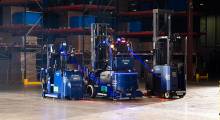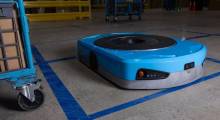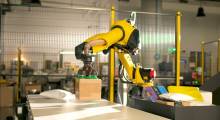Amazon is deploying a new robot to take on the extra-heavy lifting in its fulfillment centers. The new technology, the Titan mobile robot, is designed to help carry products across fulfillment centers, supporting safety and efficiency in operations.
Titan builds off over a decade of innovations in mobile robotics at Amazon and can lift up to two times more weight than Hercules, the most broadly deployed robot within the giant’s fulfillment operations. Titan’s first task will be to carry larger, bulkier items like small household appliances or pallets of pet food and gardening equipment.
Titan integrates several technologies from previous mobile robots, including the battery and charging management solution from Hercules, and the computer vision, obstacle detection, and user control systems from the Xanthus mobile robot. Titan also uses hardware components from Proteus to manage its operating system as it plans, executes, and interfaces with other technologies within the facility.
The Hercules drive unit carries heavy totes of items across Amazon fulfillment centers. Xanthus helps carry small, individual items across fulfillment centers, and Proteus is the first mobile robot able to autonomously move through Amazon facilities using advanced safety, perception, and navigation technology developed by Amazon.
Amazon’s SAT1 fulfillment center in San Antonio, Texas, is the first to deploy Titan in its operations. The facility launched in 2013 to process larger, bulkier items, and the use of this new technology will help modernize the site, supporting both workplace safety and efficiency. Amazon envisions many possibilities for Titan’s rise going forward, including with containerized storage solutions like Sequoia where it could transport inventory across the storage floor and bring it directly to employees.
Mobile robots like Titan work collaboratively with other robotics systems to create a safer and more ergonomic workplace that reduces repetitive motions, eliminates the need for employees to walk long distances or move heavy objects, and allows employees to focus on new tasks that require new skills.
To date, Amazon has deployed over 750,000 robots across its fulfillment centers globally. Company data shows that recordable incident rates and lost-time incident rates were 15% and 18% lower, respectively, at Amazon Robotics sites than they were at its non-robotics sites in 2022.
For a look at Amazon’s robotics lineup, check out this video.
Article topics
Email Sign Up
















